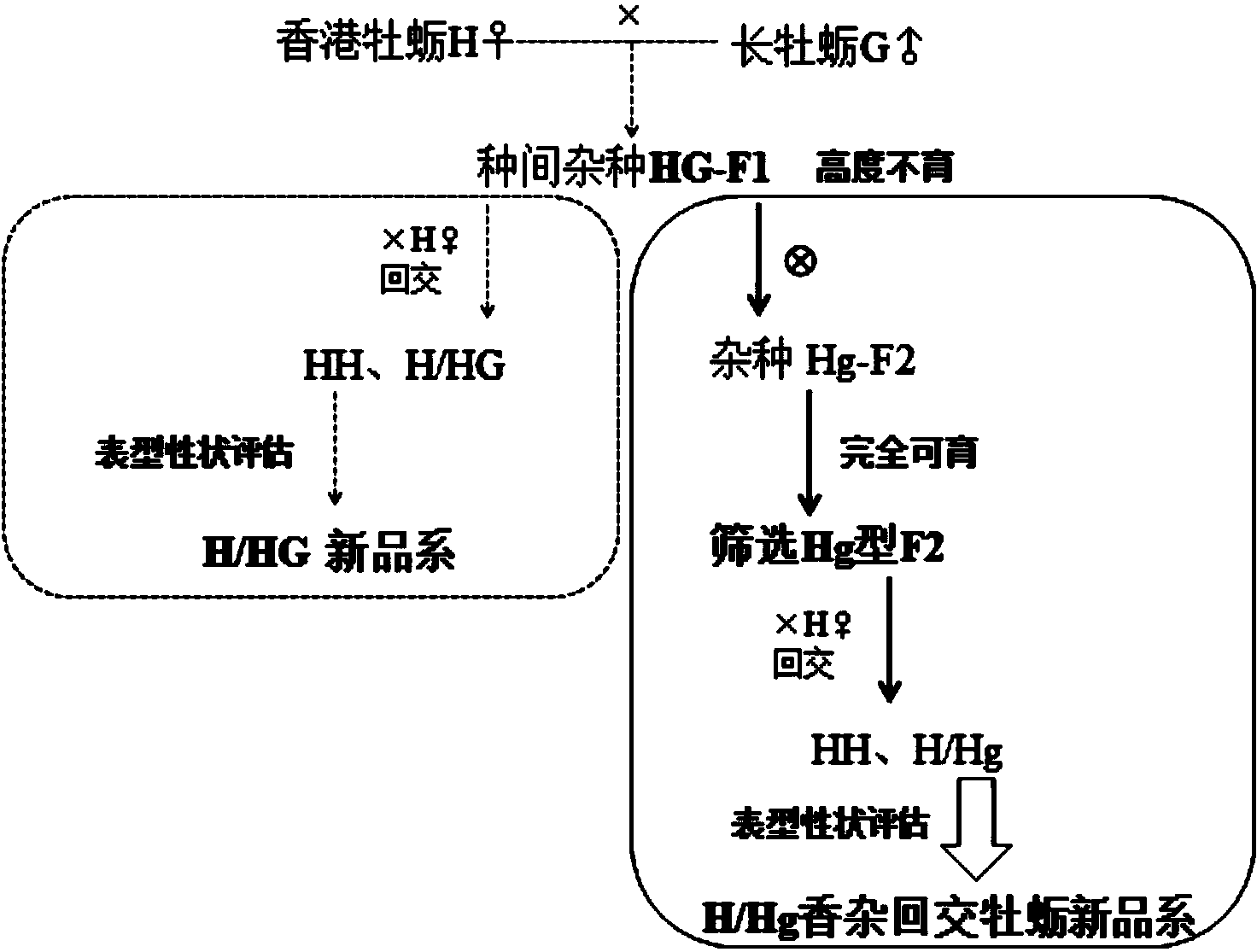Breeding method for new line of backcross Crassostrea hongkongensis and hybrid gigas
A breeding method and technology of new strains, applied in the field of cultivation of new strains of fragrant hybrid backcross oysters, can solve the problems of high sterility of hybrid F1, and achieve the effects of easy promotion, strong practicability, and wide temperature range
- Summary
- Abstract
- Description
- Claims
- Application Information
AI Technical Summary
Problems solved by technology
Method used
Image
Examples
Embodiment 1
[0020] a. Egg preparation: In July 2012, in the Dalian Zhuanghe marine shellfish seedling farm, the Hong Kong oysters that were airlifted from Shenzhen to Dalian in May were used as materials, and placed in the shrimp pond of the farm for ecological ripening. At the beginning of July, the gonads of oysters in Hong Kong were mature, and 15 female individuals were screened out to obtain individual eggs through dissection; each individual egg was filtered through a 200-mesh sieve, and concentrated with a 400-mesh silk screen; then placed in a 2L fresh seawater red bucket for soaking After 30-60 minutes, the germinal vesicles rupture and become mature eggs.
[0021] b. Sperm preparation: Self-propagation using the highly sterile Hong Kong oyster Crassssotrea hongkongensis and long oyster C.gigas hybrid F1 (reference literature: Zhang Yuehuan et al., Hong Kong giant oyster and long oyster interspecific hybridization and early heterosis analysis, Journal of Fisheries, 36(9), 2012, 9...
Embodiment 2
[0025] a. Egg preparation: In June 2012, during the oyster breeding season in Hong Kong, 30 female individuals were screened out in the shellfish seedling field of the Zhanjiang Special Aquatic Animal Experimental Station of the South China Sea Institute of Oceanology, Chinese Academy of Sciences to obtain individual eggs through dissection; An individual egg is filtered through a 200-mesh sieve, and concentrated by a 400-mesh sieve silk screen; then placed in a 5L fresh seawater red bucket and soaked for 30-60 minutes, the germinal vesicles burst and become mature eggs.
[0026] b. Sperm preparation: using highly sterile Hong Kong oyster and long oyster hybrid F1 for self-propagation, screening out 10 fully fertile male individuals with hybrid F1 genotype in hybrid F2 as materials, and dissected to obtain fresh Single sperm, 100mL semen is obtained by filtering through 500 sieve silk nets, activated by sea water for 5-10min, and actively beating under the microscope is the spe...
Embodiment 3
[0030]a. Egg preparation: In July 2013, during the oyster breeding season in Hong Kong, 36 female individuals were screened out in the shellfish seedling field of the Zhanjiang Special Aquatic Animal Experimental Station of the South China Sea Institute of Oceanology, Chinese Academy of Sciences to obtain single egg by dissection; An individual egg is filtered through a 200-mesh sieve, and concentrated by a 400-mesh sieve silk screen; then placed in a 5L fresh seawater red bucket and soaked for 30-60 minutes, the germinal vesicles burst and become mature eggs.
[0031] b. Sperm preparation: Using highly sterile Hong Kong oyster and long oyster hybrid F1 for self-propagation, 12 fully fertile male individuals with hybrid F1 genotype in hybrid F2 were selected by molecular markers as materials, and freshly obtained by dissection Single sperm, 100mL semen is obtained by filtering through 500 sieve silk nets, activated by sea water for 5-10min, and actively beating under the micros...
PUM
 Login to View More
Login to View More Abstract
Description
Claims
Application Information
 Login to View More
Login to View More - R&D
- Intellectual Property
- Life Sciences
- Materials
- Tech Scout
- Unparalleled Data Quality
- Higher Quality Content
- 60% Fewer Hallucinations
Browse by: Latest US Patents, China's latest patents, Technical Efficacy Thesaurus, Application Domain, Technology Topic, Popular Technical Reports.
© 2025 PatSnap. All rights reserved.Legal|Privacy policy|Modern Slavery Act Transparency Statement|Sitemap|About US| Contact US: help@patsnap.com

